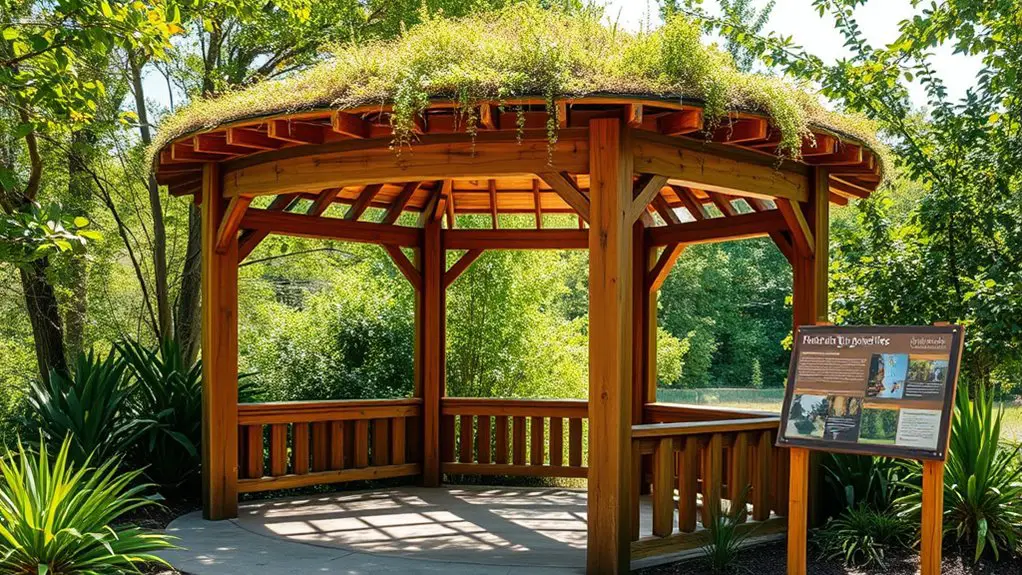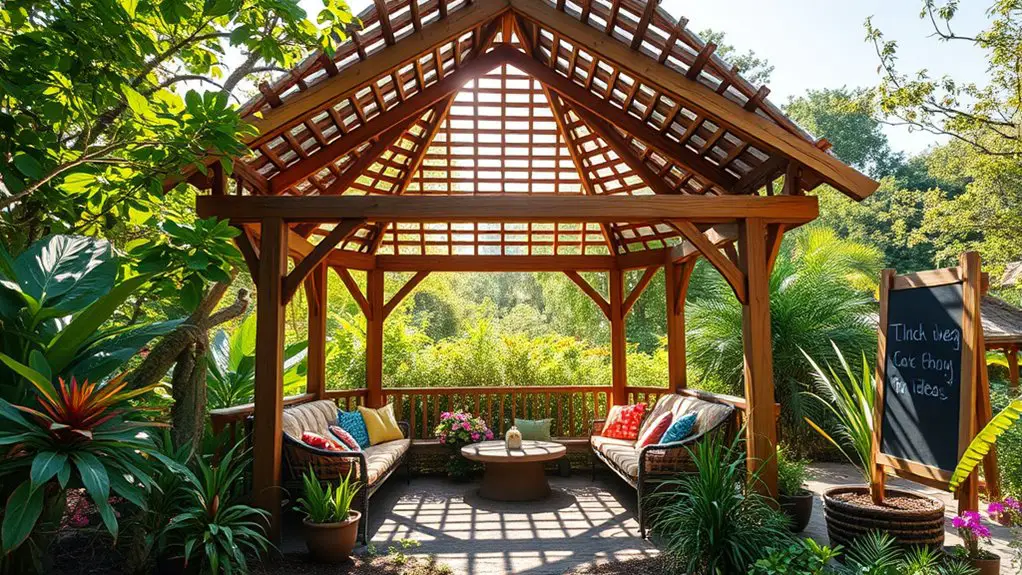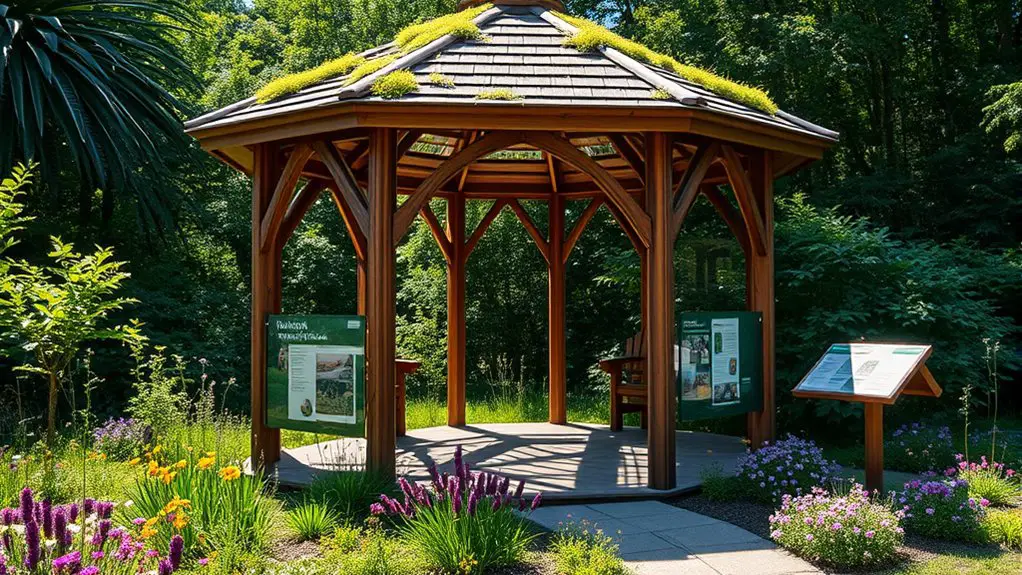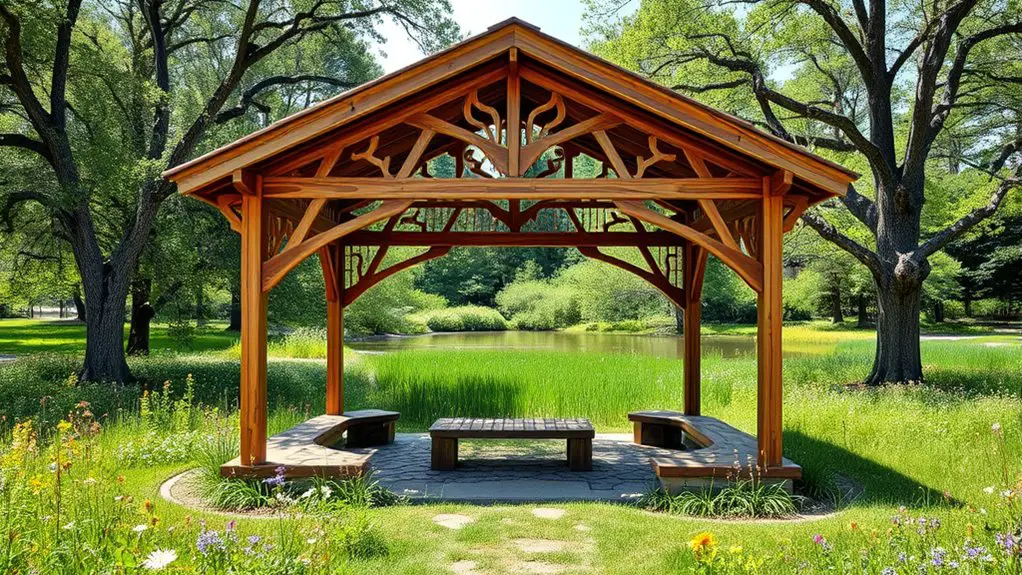The best gazebo designs for environmental education centers combine sustainable materials and innovative layouts to create an immersive experience. Opt for recycled wood or bamboo to enhance durability and eco-friendliness. Circular seating promotes collaboration, while zoned areas encourage diverse learning. Integrate nature with wildlife habitats and serene water features to inspire connection. Aesthetic touches like educational murals and green roofs foster awareness. Explore how these elements come together to enrich your educational vision.
Sustainable Materials for Eco-Friendly Gazebo Designs

When envisioning a gazebo that harmonizes with nature, the choice of materials is essential. You’ll find that recycled wood makes an excellent foundation, offering a rustic charm while minimizing waste. Its unique textures and colors tell a story of sustainability, inviting you to connect with the earth. Pair this with bamboo structures, which are not just lightweight but also incredibly strong. Bamboo grows rapidly, making it a renewable resource that embodies freedom and resilience.
Imagine a gazebo surrounded by lush greenery, where the natural materials blend seamlessly into your environment. By choosing these sustainable options, you’re crafting a space that not only educates but inspires. The gentle sway of bamboo in the breeze and the warmth of recycled wood create an atmosphere of tranquility. This is more than just a structure; it’s a sanctuary for learning and reflection, encouraging everyone to embrace eco-friendly practices. Additionally, selecting wood that is resistant to insects and rot helps ensure the longevity of your gazebo while maintaining its natural appeal.
Innovative Layouts to Enhance Learning Experiences
Crafting innovative layouts for your gazebo can greatly enhance the learning experiences offered at environmental education centers. By designing spaces that encourage exploration and engagement, you can create a vibrant atmosphere for interactive workshops and outdoor classrooms. Consider these four layout ideas:
- Circular Seating: Arrange benches in a circle to foster discussion and collaboration, allowing participants to face each other naturally.
- Zoned Areas: Divide the gazebo into distinct sections for different activities, like a nature study corner and a hands-on planting area, encouraging diverse learning opportunities.
- Open Flow: Maintain an unobstructed center to facilitate movement and interaction, ensuring your space feels inviting and free.
- Integrated Nature: Incorporate planters or natural elements into your design, reminding participants of the environment they’re studying and inspiring a deeper connection to nature.
Additionally, utilizing adequate shade from the gazebo can enhance comfort during outdoor learning sessions, making it easier for participants to focus on their educational activities. These layouts not only promote learning but also celebrate the beauty of the outdoors.
Multi-Functional Gazebos for Community Engagement

While fostering community engagement is essential for environmental education centers, multi-functional gazebos can serve as the perfect hub for diverse activities. Imagine transforming your gazebo into an inviting space for community workshops, where locals gather to share knowledge, skills, and experiences. These structures can seamlessly blend into outdoor classrooms, providing shelter while encouraging hands-on learning amidst nature.
With flexible seating and adaptable layouts, your gazebo can host everything from art classes to gardening demonstrations, sparking creativity and collaboration. Picture families exploring sustainable practices or children discovering the wonders of wildlife—all under the protective cover of a beautifully designed gazebo. Additionally, these gazebos can enhance outdoor experiences for outdoor enjoyment and connection to nature, making them vital components of community spaces.
Using eco-friendly materials and sustainable designs, your gazebo can reflect the values of your center, promoting awareness and appreciation for the environment. Ultimately, these multi-functional spaces not only enhance learning but also strengthen community bonds, fostering a spirit of togetherness and shared responsibility for our planet.
Integrating Nature and Wildlife Into Gazebo Design
As you envision your gazebo, consider how it can become a seamless extension of the surrounding ecosystem, inviting nature and wildlife to thrive within and around it. By integrating elements that promote wildlife observation and nature immersion, you’ll create a sanctuary that connects people with the natural world.
Envision your gazebo as a natural sanctuary, inviting wildlife and fostering a deep connection with the surrounding ecosystem.
- Natural Materials: Use sustainably sourced wood and stone to blend your gazebo harmoniously with its environment.
- Wildlife Habitat Features: Incorporate birdhouses, bee hotels, and native plant gardens to attract local fauna.
- Open Design: Opt for wide, open seating that allows for unobstructed views of the surrounding wildlife, encouraging observation and appreciation.
- Water Elements: Add small ponds or fountains to create a serene atmosphere, inviting birds and butterflies to visit.
Additionally, selecting a gazebo with a steel frame ensures greater durability and stability against the elements, enhancing the longevity of your educational center’s outdoor space.
Aesthetic Features That Promote Environmental Awareness

How can the aesthetic elements of your gazebo inspire a deeper connection to the environment? By integrating vibrant educational murals and interactive displays, you can create a visually stunning space that captivates and educates visitors. Imagine stepping into a gazebo adorned with murals depicting local ecosystems, inviting you to explore the intricate relationships within nature.
Interactive displays can engage all ages, allowing you to touch, listen, and discover the wonders of your surroundings firsthand. Consider using sustainable materials that blend harmoniously with the landscape, such as reclaimed wood or eco-friendly paints, reinforcing your commitment to the environment. Additionally, incorporating features that enhance the overall value of the property can attract more visitors and support your educational mission.
Natural lighting and open designs can enhance the connection to the outdoors, while green roofs or vertical gardens add a touch of life above and around you. These aesthetic features not only beautify your gazebo but also serve as powerful tools for raising environmental awareness in your community.
Frequently Asked Questions
What Is the Average Cost of Building an Eco-Friendly Gazebo?
Building an eco-friendly gazebo can feel like crafting a dream from nature’s palette, with costs ranging from $3,000 to $10,000. Consider your construction budget wisely, focusing on sustainable materials that harmonize with your surroundings.
How Long Does It Take to Build a Gazebo?
Building a gazebo typically takes one to three weeks, depending on your construction timeline and the gazebo materials you choose. Opt for sustainable options to enhance both aesthetics and environmental harmony, giving you a beautiful outdoor retreat.
Can I Design a Gazebo Myself?
Sure, you can design a gazebo yourself! Ironically, the freedom to create your own DIY gazebo means diving into design inspiration, crafting something sustainable, and embracing your unique vision—just don’t forget to measure twice!
What Permits Are Needed for Constructing a Gazebo?
When constructing a gazebo, you’ll need to check zoning regulations and building codes. These guarantee your design’s safe, sustainable, and compliant. Don’t forget to secure any necessary permits before you start your creative journey!
How Do I Maintain a Gazebo in an Outdoor Environment?
Imagine your gazebo standing proud, a sanctuary of peace. To maintain it, choose durable materials, regularly check for wear, and embrace outdoor maintenance. Clean, seal, and nurture its beauty, allowing freedom to flourish in nature’s embrace.

